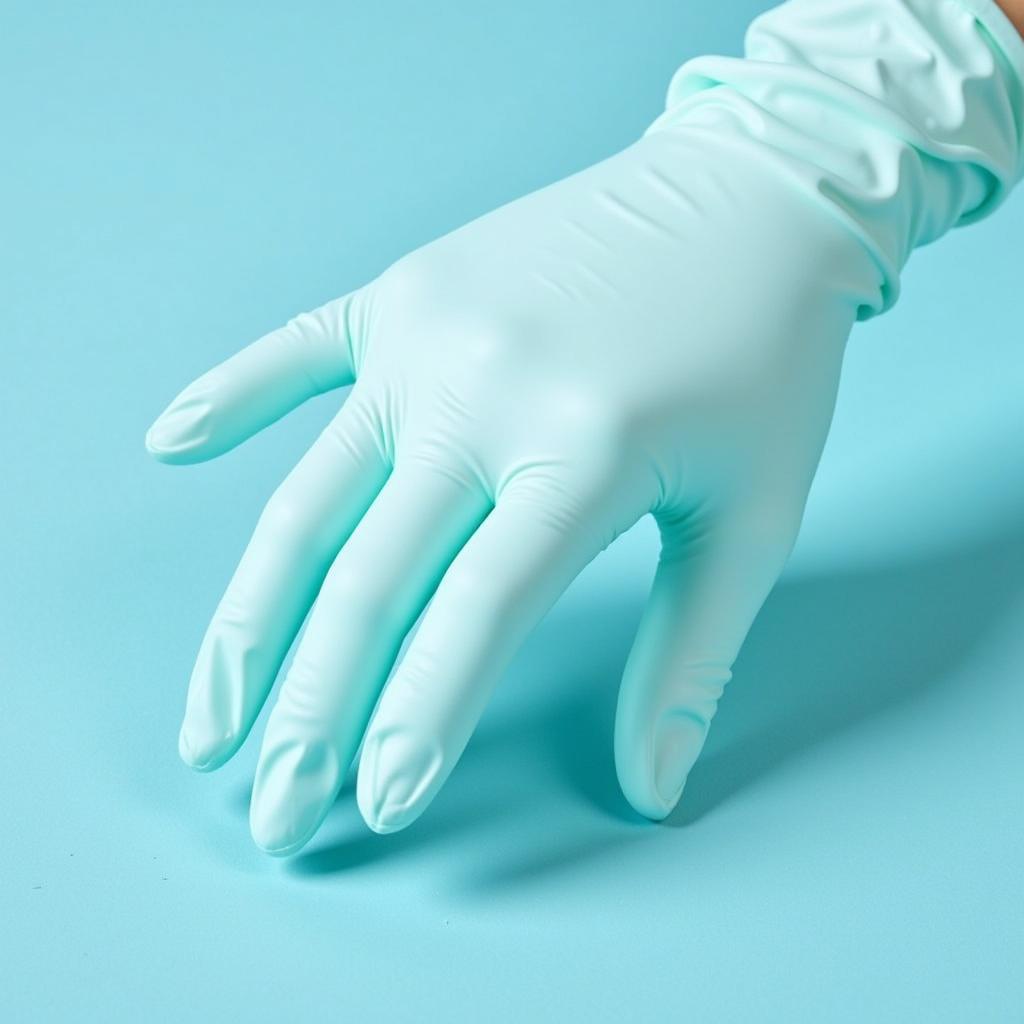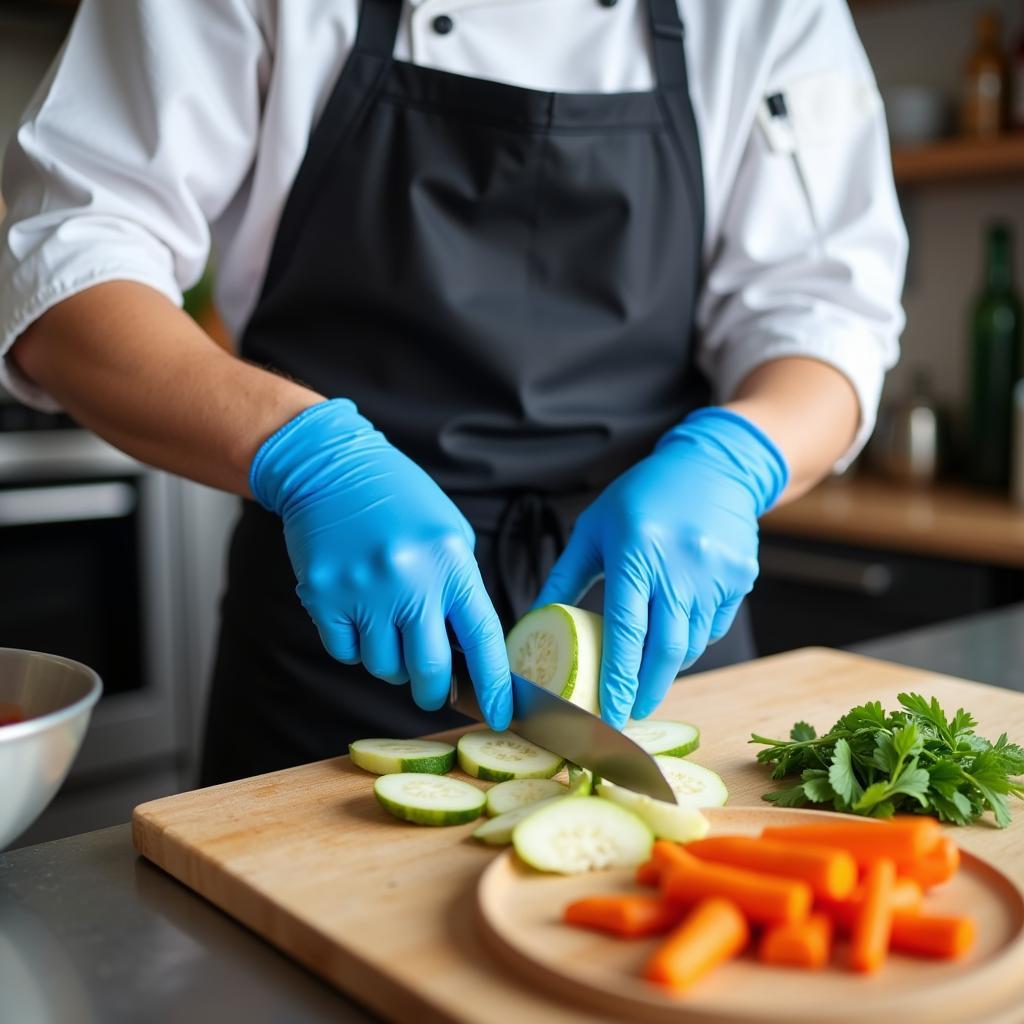When it comes to food handling, safety is paramount. Whether you’re a seasoned chef or a home cook, ensuring hygiene is non-negotiable. One common query that arises is the suitability of nitrile exam gloves for food handling. Can these gloves, primarily designed for medical use, be safely employed in culinary settings? Let’s delve into the details and answer this crucial question.
Understanding Nitrile Gloves
Nitrile gloves are a type of synthetic rubber glove renowned for their durability, puncture resistance, and chemical resistance. These attributes have made them a staple in healthcare, laboratories, and industrial settings. However, their suitability for food handling requires careful consideration.
 Close-up of nitrile exam gloves
Close-up of nitrile exam gloves
Food Safe Materials: Decoding the Standards
The term “food safe” signifies that a material, when in contact with food, will not transfer harmful substances that could compromise food safety or alter the taste and odor of the food. The U.S. Food and Drug Administration (FDA) regulates food-contact materials to ensure they meet stringent safety standards.
Nitrile, in its raw form, may contain certain chemicals that are not intended for food contact. However, food-safe nitrile gloves undergo a specialized manufacturing process that removes or minimizes these chemicals to safe levels. These gloves comply with FDA regulations for food contact, making them suitable for use in food handling environments.
Benefits of Using Nitrile Exam Gloves for Food Handling
Choosing the right gloves for food handling can significantly impact hygiene and food safety. Here’s why opting for food-safe nitrile exam gloves can be advantageous:
- Superior Protection: Nitrile offers a robust barrier against contaminants, preventing the transfer of bacteria, viruses, and other microorganisms from hands to food. This is particularly crucial when handling raw meat, poultry, and seafood.
- Enhanced Durability: Nitrile gloves are highly resistant to punctures and tears, reducing the risk of glove failure during food preparation. This durability ensures that your hands remain protected throughout the entire process.
- Chemical Resistance: Certain foods contain acids, oils, and other substances that can degrade some glove materials. Nitrile gloves provide excellent chemical resistance, ensuring their integrity and your safety when handling such ingredients.
- Latex-Free Alternative: Nitrile gloves are a suitable option for individuals with latex allergies, offering a safe and reliable alternative without compromising on protection.
 Chef wearing nitrile gloves preparing food in a professional kitchen
Chef wearing nitrile gloves preparing food in a professional kitchen
Choosing the Right Nitrile Gloves for Food Handling
Not all nitrile gloves are created equal, and selecting the appropriate type is vital. When choosing nitrile exam gloves for food handling, consider the following factors:
- FDA Compliance: Ensure the gloves are explicitly labeled as “food safe” or “FDA compliant for food contact” to guarantee their suitability for handling food.
- Glove Thickness: Thicker gloves offer increased durability and protection, making them ideal for tasks involving sharp objects or prolonged contact with food.
- Powder-Free Option: Powdered gloves can sometimes interfere with food preparation. Opting for powder-free nitrile gloves eliminates this concern and reduces the risk of contamination.
- Color-Coding System: Utilizing different colored gloves for specific tasks, such as handling raw meat versus ready-to-eat foods, can further enhance cross-contamination prevention.
Best Practices for Using Nitrile Gloves in Food Handling
While using food-safe nitrile exam gloves significantly improves hygiene, it’s essential to follow these best practices to maximize their effectiveness:
- Wash and Dry Hands: Always wash and thoroughly dry your hands before putting on gloves. This removes any existing contaminants and ensures a snug fit.
- Inspect Gloves: Before each use, carefully inspect the gloves for any tears, punctures, or signs of damage. Discard and replace damaged gloves immediately.
- Change Gloves Frequently: Replace gloves every time you switch between tasks, particularly after handling raw foods, to prevent cross-contamination.
- Avoid Touching Contaminated Surfaces: While wearing gloves, avoid touching your face, hair, or any surfaces that could potentially contaminate the gloves.
- Proper Disposal: Dispose of used gloves properly in a designated waste container. Never wash or reuse disposable gloves.
“Ensuring food safety is not just about following regulations; it’s about prioritizing the well-being of those we serve,” says renowned food safety consultant, Dr. Emily Carter. “Using appropriate protective gear, like food-safe nitrile exam gloves, is a simple yet impactful step towards creating a safer and healthier food environment.”
Conclusion
The use of nitrile exam gloves for food safe practices is acceptable provided they are specifically labeled as “food safe” and comply with FDA regulations. By adhering to best practices and choosing the right gloves, you can create a hygienic food handling environment and ensure the safety of the food you prepare and serve.
For additional resources on food safety and hygiene, you can explore our articles on vinyl gloves for food, black food gloves, and disposable food serving gloves. Remember, prioritizing food safety is a collective responsibility that starts with informed choices and responsible practices.